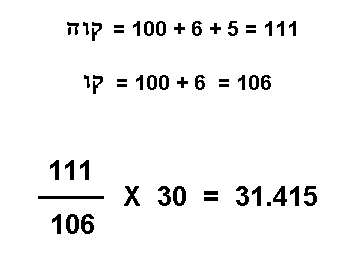
The famed Gaon of Vilna has pointed out a remarkably accurate hidden value for pi in the Book of Kings.
In this article I suggest -- contrary to the opinion of those who believe that everything is to be found in the Torah -- that the Gaon's discovery is actually evidence that the Torah is not interested in supplying Man with technical data. It is our job to discover this for ourselves in the fullness of Time.
by Jonathan Cohen
Well......yes and no. Let's start at the beginning.
3.14159265358979323846.......
Pi is the ratio between the diameter of a circle and its circumference. This means that if you want to calculate the circumference of a circle, you multiply its diameter by pi. Today any child knows that, but it wasn't always so simple.
The time was when pi was known by the approximation 22/7 ("twenty-two over seven"). Before that it was simply estimated at three.
The verse takes the simplest value for the ratio between the diameter and the circumference: 3. "Since the diameter is 10", the verse seems to say, "it follows that the circumference is 30".
"Hang on!," we all scream, "the actual circumference is 31.415... cubits!" The Bible's got it wrong!
But the resulting succah will be too small !
The famed Rabbi Eliyahu of Vilna says: If you take the numerical value of the word for diameter as it is written, divide it by the numerical value of the same word as it is read, and multiply by the value for the circumference as given in the verse, you come out with a figure which is accurate to four significant figures!
Instead, what I believe the Torah has done is pointedly abstain from giving us the value of pi.
By giving us the crude approximation of 3, and then hiding a far better (but still inaccurate) value in the qeri / ketiv, the Torah is in effect saying: "We could give you a superior value if we wanted to, but we don't want to. Use the proportion 1:3 for all halachic calculations e.g. measuring a round succah or korah). Even though it is not totally accurate it is all you need." The Torah has not given us an ultimate value because that is not the Torah's job -- that is Man's job!
So nu, is pi in the Torah? Well......yes and no.
In the First Book of Kings (Ch. 7 v. 23), when King Solomon builds the Temple, we are told:
"And he made a molten sea, ten cubits from one brim to the other -- it was round all about and its height was five cubits -- and a line of thirty cubits did circle it round about."
This ratio of 1:3 is quoted in the Talmud and Shulhan Arukh. Somebody wishing to make a circular succah, and be sure that it is large enough to fulfill the injunction, is told to measure it's diameter and multiply by three.
Now to fully appreciate this you need to open a Hebrew Bible and notice that the word used for "diameter" (vekav), is unpronouncable.
It's a case of qeri and ketiv, a word which is written one way and pronounced another. There are various theories about the origins of qeri / ketiv variations, but whatever may be the way they came about,
we believe that their existence is part of a plan. They're not there by chance. (They're a little bit like hypertext: pass you cursor over them and another layer of meaning appears.)
